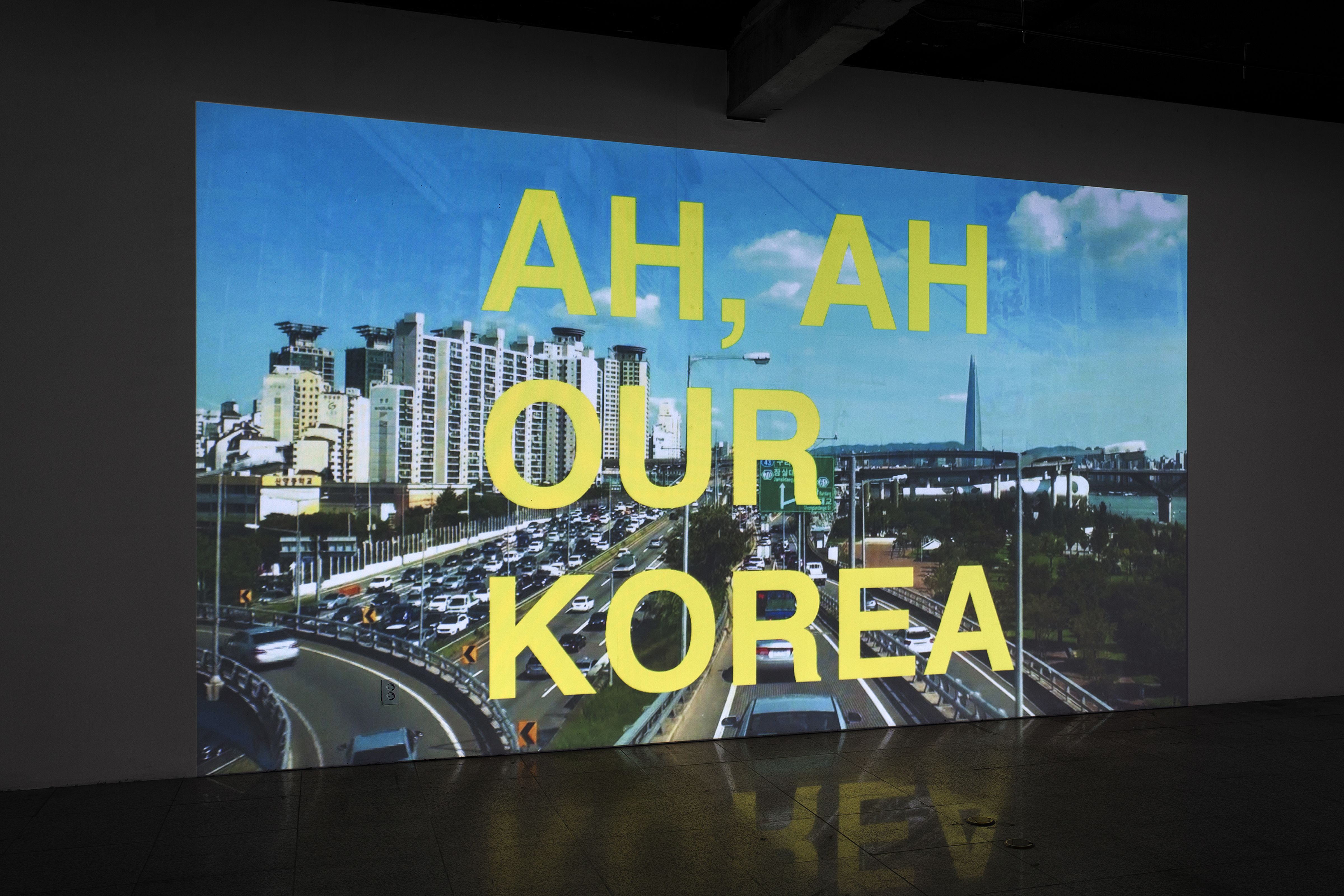18세기 중엽, 러시아의 절대군주 예카테리나 2세가 자신의 영토 중 크림반도를 시찰하려고 하자, 당시 총독이었던 포촘킨이 여제의 환심을 사기 위해 잘 정돈된 마을의 풍경을 그린 대형 가리개로 낙후된 실제 모습을 가렸던 일이 있다. 이후 ‘포촘킨 파사드’는 원래의 모습을 가린 채 선별된 전시적 풍경을 가리키는 비판적 용어로 쓰인다. ‘포촘킨’이라는 동명을 둘러싼 또 다른 이야기가 있다. 20세기 초반, 러시아 영화감독 에이젠슈테인은 영화 <전함 포촘킨>에서 영화문법 중 하나인 ‘몽타주’를 적극적으로 실험하여 새로운 형식의 영화를 선보였다. ‘전함 포촘킨’에서 몽타주는, 대조적인 쇼트들을 이어붙여 선형적 시간과 일치된 장소에서 벌어지는 서사 흐름을 의도적으로 충돌시키는 방법으로 쓰였다. 이번 작업은 ‘포촘킨(Potemkin)’이라는 동일한 이름을 둘러싼 두 개의 이야기에 대한 호기심으로부터 출발하였다. 전시화된 풍경-포촘킨 파사드-과 이미지와 소리의 재조립을 통해 구성된 제3의 시공간-전함 포촘킨-이라는 두 가지 수사학을 통해, 서울의 두 장소를 재조망하는 작업이다.
<포촘킨 스터디 1. 서울 : 침묵의 탑, 불의 집>에서는, 종묘와 대림동을 중심으로 서울을 읽는 작업을 시도했다. 500년 이상 한 자리를 지킨 하나의 성씨, 즉 ’이씨 왕조’의 상징적 공간이자 그들의 위패를 모신 성소(聖所)인 ‘종묘’. 이와 대조적으로, 산업화와 신 자유주의 경제의 물결 속에서 끊임없이 유동하는 물자와 사람들이 새로운 풍경을 이루는 ‘대림동’. 서울에는 한 번도 주인이 바뀐 적이 없는 집과, 제자리를 한 번도 갖지 못한 사람들이 함께 뒤섞여있다. 프랑스 철학자 가브리엘 마르셀은 “개인은 자신의 장소와 별개가 아니다. 그가 바로 장소이다.”라고 했다. 떠난 사람들의 집과 떠날 사람들의 집, 정주민과 이주민, 그 둘이 만들어내는 도시의 모습을 그려본다. 결국, 이것들은 우리가 만들어낸 전시적 풍경일까, 모든 장소로부터 소외되는 실존적 외부성(existential outsiderness)을 선택한 것일까. 이번 프로젝트는 여기에서부터 출발한다.
In the middle of 18th century, when Catherine the Great who was an empress of Russia planed a tour of Crimea, a Russia minister Potemkin, in order to gain her’s favour, he hid actual village landscape by the large screen which was drawn the fake, but plausible scenery. Later, ‘Potemkin facade’ used to be known as a satirical architectural terms, it signifies the selected landscape by covering the original one.
There is another story of ‘Potemkin. Early 20th century, a Russian film maker, Sergei Eisenstein did study actively “montage” that is the grammar of a film, it promoted him to present a new style. In his film, Battleship Potemkin, montage was used for purpose that educe the new concept by assembling contrasting two scenes, instead of accumulating the meaning of narrative structure through just combining each shot. It is the way of an intentional collision against natural narrative flow. The beginning point of my new work is the curiosity of surrounding two story of the name of Potemkin. I tried to explore and read two different places in Seoul through two aspects: Selected landscape(Potemkin facade) and the Third Time and Place that is comprised of reassembled images by montage.(Battleship Potemkin)
In my video Potemkin Study 1. Seoul : Tower of Silence, Fire Temple, I tried to study on Jongmyo and Daerim-dong in Seoul. Jongmyo is a shrine and a symbolic place of the Joseon Dynasty that was ruled by only people with the family name Lee for 500 years, at the one place. In contrast, Daerim-dong forms the new landscape by ceaselessly moving supplies and people due to the industrialization and the dominance of neoliberalism. In Seoul, there is a home that is never changed the house owner also people who never got their own place. A french philosopher, Gabriel Marcel said, “An individual is not distinct from his place. He is his place.” I pictured the city landscape that is composed of immigrants and natives, the home where people left or ready to leave someday. Is that selected landscape we made? or is that a choice by the existential outsideness which alienated from all the place? I started this project from these questions.
안유리 An Yuri
안유리는 지난 몇 년 간 이동하는 삶을 살면서 장소는 존재하나 그곳에 살았던 사라진 말과 이야기들에 관심을 가지게 되었다. 대상을 재현하여 물성에 박제하기보다, 지금, 이곳의 시공간으로 불러내어 지켜보는 것을 선호한다. 때문에 텍스트, 비디오, 사운드처럼 시공간의 이동이 자유로운 매체에 담아 표현한다. 2016년 이래, 코리안 디아스포라 프로젝트를 진행하고 있다. 2014년 헤리트 리트벨트 아카데미(Gerrit Rietveld Academie)를 졸업한 후 한국으로 돌아왔다.
2015년 서울시립미술관 신진작가 전시지원 프로그램에 선정되어 첫 개인전 <추수할 수 없는 바>(아트 스페이스 풀, 서울, 2015)를 열었고, 이후 두 번째 개인전 <항해하는 말들>(청주미술창작스튜디오, 청주, 2015), 서울문화재단 서교예술실험센터 유망예술 시각예술분야에 선정되어 세 번째 개인전 <돌아오지 않는 강>(서교예술실험센터, 서울, 2016)을 열었다. 주요 그룹전으로 <Neo Geography 1>(뉴샤텔 예술센터, 뉴샤텔, 2017), <Neo Geography 2>(탈영역 우정국, 서울, 2017), <당신은 몰랐던 이야기>(국립현대미술관 서울관, 서울, 2018), 경기도미술관-가오슝미술관 교류 주제전 <Moving & Migration>(가오슝미술관, 대만 + 경기도미술관, 안산, 2019) <모두 말하기 : 파레시아>(청주시립대청호미술관, 청주, 2020)등이 있다.
Yuri An has been living a moving life in the past years. She became interested in disappeared words and stories those lived in there before even though place still existed. Instead of immobilizing a material property by doing reproduction of object, she prefers watching it by recalling to here and now. Therefore, she expresses her work through medium that easy to mobile such as text, video and sound. Since 2016, She focuses on Korean Diaspora project. She graduated from Gerrit Rieveld Academie in Amsterdam, the Netherlands and came back to Korea in 2014.
Yuri An was selected as <Emerging Artists 2015 of Seoul Museum of Art>, then she held her first solo exhibition The Unharvested Sea(Art Space Pool, Seoul, 2015). In the same year, she held second solo exhibition Sailing Words(Cheongju Art Studio, Cheongju, 2015). Her third solo exhibition River of No return(Seoul Art Space Seogyo, Seoul, 2016) held due to support by Seoul Foundation for Arts and Culture. She participated in several group exhibitions: Neo Geography 1(Centre d'art Neuchâtel, Switzerland, 2017), Neo Geography 2(Post Territory Ujeongguk, Seoul, 2017), How little you know about me(National Museum of Modern and Contemporary Art, Korea, 2018), Moving & Migration(Kaohsiung Museum of Fine Arts, Taiwan + Gyeonggi Museum of Modern Art, Ansan, 2019), To Speak Everything: Parrhesia(CMOA Daecheongho Museum of Art, Cheongju, 2020)
